Characteristics of Merging Plasma Plumes for Materials Process Using Two Atmospheric Pressure Plasma Jets
Abstract
:1. Introduction
2. Materials and Methods
3. Results
3.1. Electrical Diagnosis
3.2. Discharge Images
3.3. Optical Emission Spectroscopy (OES)
4. Discussion and Conclusions
Author Contributions
Funding
Institutional Review Board Statement
Informed Consent Statement
Data Availability Statement
Acknowledgments
Conflicts of Interest
References
- Von Woedtke, T.; Emmert, S.; Metelmann, H.; Rupf, S.; Weltmann, K. Perspectives on cold atmospheric plasma (CAP) applications in medicine. Phys. Plasmas 2020, 27, 070601. [Google Scholar] [CrossRef]
- Yoon, Y.J.; Suh, M.J.; Lee, H.Y.; Lee, H.J.; Choi, E.H.; Moon, I.S.; Song, K. Anti-tumor effects of cold atmospheric pressure plasma on vestibular schwannoma demonstrate its feasibility as an intra-operative adjuvant treatment. Free Radic. Biol. Med. 2018, 115, 43–56. [Google Scholar] [CrossRef] [PubMed]
- Stancampiano, A.; Bocanegra, P.E.; Dozias, S.; Pouvesle, J.; Robert, E. Evidence, Origin and impact of liquid flows in plasma medicine in vitro treatments with APPJs. Plasma Sources Sci. Technol. 2021, 30, 015002. [Google Scholar] [CrossRef]
- Liew, P.J.; Yap, C.Y.; Wang, J.; Zhou, T.; Yan, J. Surface modification and functionalization by electrical discharge coating: A comprehensive review. Int. J. Extrem. Manuf. 2020, 2, 012004. [Google Scholar] [CrossRef]
- Luque-Agudo, V.; Hierro-Oliva, M.; Gallardo-Moreno, A.M.; González-Martín, M.L. Effect of plasma treatment on the surface properties of polylactic acid films. Polym. Test. 2021, 96, 107097. [Google Scholar] [CrossRef]
- Kehrer, M.; Rottensteiner, A.; Hartl, W.; Duchoslav, J.; Thomas, S.; Stifter, D. Cold atmospheric pressure plasma treatment for adhesion improvement on polypropylene surfaces. Surf. Coat. Technol. 2020, 403, 126389. [Google Scholar] [CrossRef]
- Chen, Z.; Xu, R.; Chen, P.; Wang, Q. Potential agricultural and biomedical applications of cold atmospheric plasma-activated liquids with self-organized patterns formed at the interface. IEEE Trans. Plasma Sci. 2020, 48, 3455–3471. [Google Scholar] [CrossRef]
- Bradu, C.; Kutasi, K.; Magureanu, M.; Puač, N.; Živković, S. Reactive nitrogen species in plasma-activated water: Generation, chemistry and application in agriculture. J. Phys. D 2020, 53, 223001. [Google Scholar] [CrossRef]
- Tomeková, J.; Kyzek, S.; Medvecká, V.; Gálová, E.; Zahoranová, A. Influence of cold atmospheric pressure plasma on pea seeds: DNA damage of seedlings and optical diagnostics of plasma. Plasma Chem. Plasma Process 2020, 40, 1571–1584. [Google Scholar] [CrossRef]
- Rajan, A.; Boopathy, B.; Radhakrishnan, M.; Rao, L.; Schlüter, O.K.; Tiwari, B.K. Plasma processing: A sustainable technology in agri-food processing. Sustain. Food Technol. 2023, 1, 9–49. [Google Scholar] [CrossRef]
- Penkov, O.V.; Khadem, M.; Lim, W.; Kim, D. A review of recent applications of atmospheric pressure plasma jets for materials processing. J. Coat. Technol. Res. 2015, 12, 225–235. [Google Scholar] [CrossRef]
- Choi, H.Y.; Kang, S.C.; Park, S.J.; Yoo, H.I.; Jeon, S.; Kim, T.; Moon, S.Y. Multifunctional surface treatment of boron nitride nanotube-coated polyimide films with atmospheric-pressure cold plasma. Plasma Process. Polym. 2024, 21, e2400031. [Google Scholar] [CrossRef]
- Liu, J.; Song, J.; Chen, Y.; Zhang, J.; Wu, L.; Wang, G.; Zhang, F.; Liu, Z.; Sun, J.; Liu, S. Atmospheric pressure cold plasma jet–assisted micro-milling TC4 titanium alloy. Int. J. Adv. Manuf. Technol. 2021, 112, 2201–2209. [Google Scholar] [CrossRef]
- Darny, T.; Pouvesle, J.; Fontane, J.; Joly, L.; Dozias, S.; Robert, E. Plasma action on helium flow in cold atmospheric pressure plasma jet experiments. Plasma Sources Sci. Technol. 2017, 26, 105001. [Google Scholar] [CrossRef]
- Wang, R.; Gao, Y.; Zhang, C.; Yan, P.; Shao, T. Dynamics of plasma bullets in a microsecond-pulse-driven atmospheric-pressure he plasma jet. IEEE Trans. Plasma Sci. 2016, 44, 393–397. [Google Scholar] [CrossRef]
- Xiong, Q.; Nikiforov, A.Y.; González, M.A.; Leys, C.; Lu, X.P. Characterization of an atmospheric helium plasma jet by relative and absolute optical emission spectroscopy. Plasma Sources Sci. Technol. 2012, 22, 015011. [Google Scholar] [CrossRef]
- Van Gaens, W.; Bogaerts, A. Reaction pathways of biomedically active species in an Ar plasma jet. Plasma Sources Sci. Technol. 2014, 23, 035015. [Google Scholar] [CrossRef]
- Shao, X.; Chang, Z.; Mu, H.; Liao, W.; Zhang, G. Experimental and numerical investigation on the interaction between Ar flow channel and Ar plasma jet at atmospheric pressure. IEEE Trans. Plasma Sci. 2013, 41, 899–906. [Google Scholar] [CrossRef]
- Jiang, S.; Shi, G.; Wang, Y.; Li, Z.; Rao, J.; Wu, Z. Discharge Characteristics of Atmospheric Pressure Ar/N2/O2 a Plasma Jet Under a Square Wave Pulse. IEEE Trans. Plasma Sci. 2022, 50, 3652–3658. [Google Scholar] [CrossRef]
- Wang, C.; Srivastava, N. OH number densities and plasma jet behavior in atmospheric microwave plasma jets operating with different plasma gases (Ar, Ar/N2, and Ar/O2). Eur. Phys. J. D 2010, 60, 465–477. [Google Scholar] [CrossRef]
- Ellerweg, D.; Benedikt, J.; von Keudell, A.; Knake, N.; Schulz-von der Gathen, V. Characterization of the effluent of a He/O2 microscale atmospheric pressure plasma jet by quantitative molecular beam mass spectrometry. New J. Phys. 2010, 12, 013021. [Google Scholar] [CrossRef]
- Thiyagarajan, M.; Sarani, A.; Nicula, C. Optical emission spectroscopic diagnostics of a non-thermal atmospheric pressure helium-oxygen plasma jet for biomedical applications. J. Appl. Phys. 2013, 113, 233302. [Google Scholar] [CrossRef]
- Kong, D.; Zhu, P.; He, F.; Han, R.; Yang, B.; Wang, M.; Ouyang, J. Influence of nitrogen and oxygen admixture on the development of helium atmospheric-pressure plasma jet. J. Appl. Phys. 2021, 129, 103303. [Google Scholar] [CrossRef]
- Jõgi, I.; Talviste, R.; Raud, S.; Raud, J.; Plank, T.; Moravský, L.; Klas, M.; Matejčík, Š. Comparison of two cold atmospheric pressure plasma jet configurations in argon. Contrib. Plasma Phys. 2020, 60, e201900127. [Google Scholar] [CrossRef]
- Wei, G.; Ren, C.; Qian, M.; Nie, Q. Optical and electrical diagnostics of cold Ar atmospheric pressure plasma jet generated with a simple DBD configuration. IEEE Trans. Plasma Sci. 2011, 39, 1842–1848. [Google Scholar] [CrossRef]
- Walsh, J.L.; Shi, J.J.; Kong, M.G. Contrasting characteristics of pulsed and sinusoidal cold atmospheric plasma jets. Appl. Phys. Lett. 2006, 88, 171501. [Google Scholar] [CrossRef]
- Tang, T.Y.; Lee, H.; Kim, H.S.; Kim, G.H.; Lee, B.; Kim, H.J.; Lee, H.J. Polymerdimethylsiloxane surface treatment with an atmospheric pressure helium plasma jet driven by unipolar nanosecond pulses. Curr. Appl. Phys. 2021, 29, 9–17. [Google Scholar] [CrossRef]
- Kim, J.Y.; Ballato, J.; Kim, S. Intense and energetic atmospheric pressure plasma jet arrays. Plasma Process. Polym. 2012, 9, 253–260. [Google Scholar] [CrossRef]
- Wan, M.; Liu, F.; Fang, Z.; Zhang, B.; Wan, H. Influence of gas flow and applied voltage on interaction of jets in a cross-field helium plasma jet array. Phys. Plasmas 2017, 24, 093514. [Google Scholar] [CrossRef]
- Douat, C.; Fleury, M.; Laroussi, M.; Puech, V. Interactions between two counter-propagating plasma bullets. IEEE Trans. Plasma Sci. 2011, 39, 2298–2299. [Google Scholar] [CrossRef]
- Douat, C.; Bauville, G.; Fleury, M.; Laroussi, M.; Puech, V. Dynamics of colliding microplasma jets. Plasma Sources Sci. Technol. 2012, 21, 034010. [Google Scholar] [CrossRef]
- Cho, G.; Kim, J.; Kang, H.; Kim, Y.; Kwon, G.; Uhm, H.S. Electrical potential measurement in plasma columns of atmospheric plasma jets. J. Appl. Phys. 2012, 112, 103305. [Google Scholar] [CrossRef]
- Johnson, M.J.; Brown, G.H.; Boris, D.R.; Petrova, T.B.; Walton, S.G. Phase-shifted counter-propagating atmospheric pressure plasma jets: Characterization and interaction with materials. J. Vac. Sci. Technol. B 2024, 42, 034004. [Google Scholar] [CrossRef]
- Johnson, M.J.; Brown, G.H.; Boris, D.R.; Petrova, T.B.; Walton, S.G. Two Atmospheric Pressure Plasma Jets Driven by Phase-Shifted Voltages: A Method to Control Plasma Properties at the Plasma–Surface Interface. IEEE Trans Plasma Sci 2022, 50, 2961–2971. [Google Scholar] [CrossRef]
- Tang, T.Y.; Kim, H.S.; Kim, G.H.; Lee, B.; Lee, H.J. Optical diagnostics of the characteristics of a square unipolar nanosecond pulse-driven atmospheric pressure helium plasma jet. AIP Adv. 2020, 10, 125218. [Google Scholar] [CrossRef]
- Settles, G.S. Schlieren and Shadowgraph Techniques: Visualizing Phenomena in Transparent Media; Springer Science & Business Media: Berlin, Germany, 2001. [Google Scholar]
- Boivin, R.F.; Scime, E.E. Control of nitrogen species in helicon plasmas. Plasma Sources Sci. Technol. 2005, 14, 283. [Google Scholar] [CrossRef]
- Berrington, K.A.; Burke, P.G.; Freitas, L.C.G.; Kingston, A.E. Electron excitation from the 11S, 23S and 21S states of helium. An eleven-state R-matrix calculation. J. Phys. B At. Mol. Phys. 1985, 18, 4135. [Google Scholar] [CrossRef]
- Arthur, N.A.; Foster, J.E.; Barnat, E.V. Laser collisional induced fluorescence electron density measurements as a function of ring bias and the onset of anode spot formation in a ring cusp magnetic field. Plasma Sources Sci. Technol. 2018, 27, 055020. [Google Scholar] [CrossRef]
- Pastor, P.C.; Giusfredi, G.; Natale, P.D.; Hagel, G.; De Mauro, C.; Inguscio, M. Absolute Frequency Measurements of the 2 3 S 1→ 2 3 P 0, 1, 2 Atomic Helium Transitions around 1083 nm. Phys Rev Lett 2004, 92, 023001. [Google Scholar] [CrossRef]
- Jarrige, J.; Laroussi, M.; Karakas, E. Formation and dynamics of plasma bullets in a non-thermal plasma jet: Influence of the high-voltage parameters on the plume characteristics. Plasma Sources Sci. Technol. 2010, 19, 065005. [Google Scholar] [CrossRef]
- Barnat, E.V.; Frederickson, K. Two-dimensional mapping of electron densities and temperatures using laser-collisional induced fluorescence. Plasma Sources Sci. Technol. 2010, 19, 055015. [Google Scholar] [CrossRef]
- Chen, S.; Chen, X.; Yao, C.; Xu, G.; Chang, Z.; Zhang, G. Electrical and spectral characterization of an atmospheric pressure He/CF4 plasma jet. Phys. Plasmas 2018, 25, 083510. [Google Scholar] [CrossRef]
- Joh, H.M.; Kang, H.R.; Chung, T.H.; Kim, S.J. Electrical and optical characterization of atmospheric-pressure helium plasma jets generated with a pin electrode: Effects of the electrode material, ground ring electrode, and nozzle shape. IEEE Trans. Plasma Sci. 2014, 42, 3656–3667. [Google Scholar] [CrossRef]
- Zhu, W.; Li, Q.; Zhu, X.; Pu, Y. Characteristics of atmospheric pressure plasma jets emerging into ambient air and helium. J. Phys. D 2009, 42, 202002. [Google Scholar] [CrossRef]
- Plenge, J.; Wirsing, A.; Raschpichler, C.; Meyer, M.; Rühl, E. Chirped pulse multiphoton ionization of nitrogen: Control of selective rotational excitation in N2 (B Σ2u). J. Chem. Phys. 2009, 130, 244313. [Google Scholar] [CrossRef]


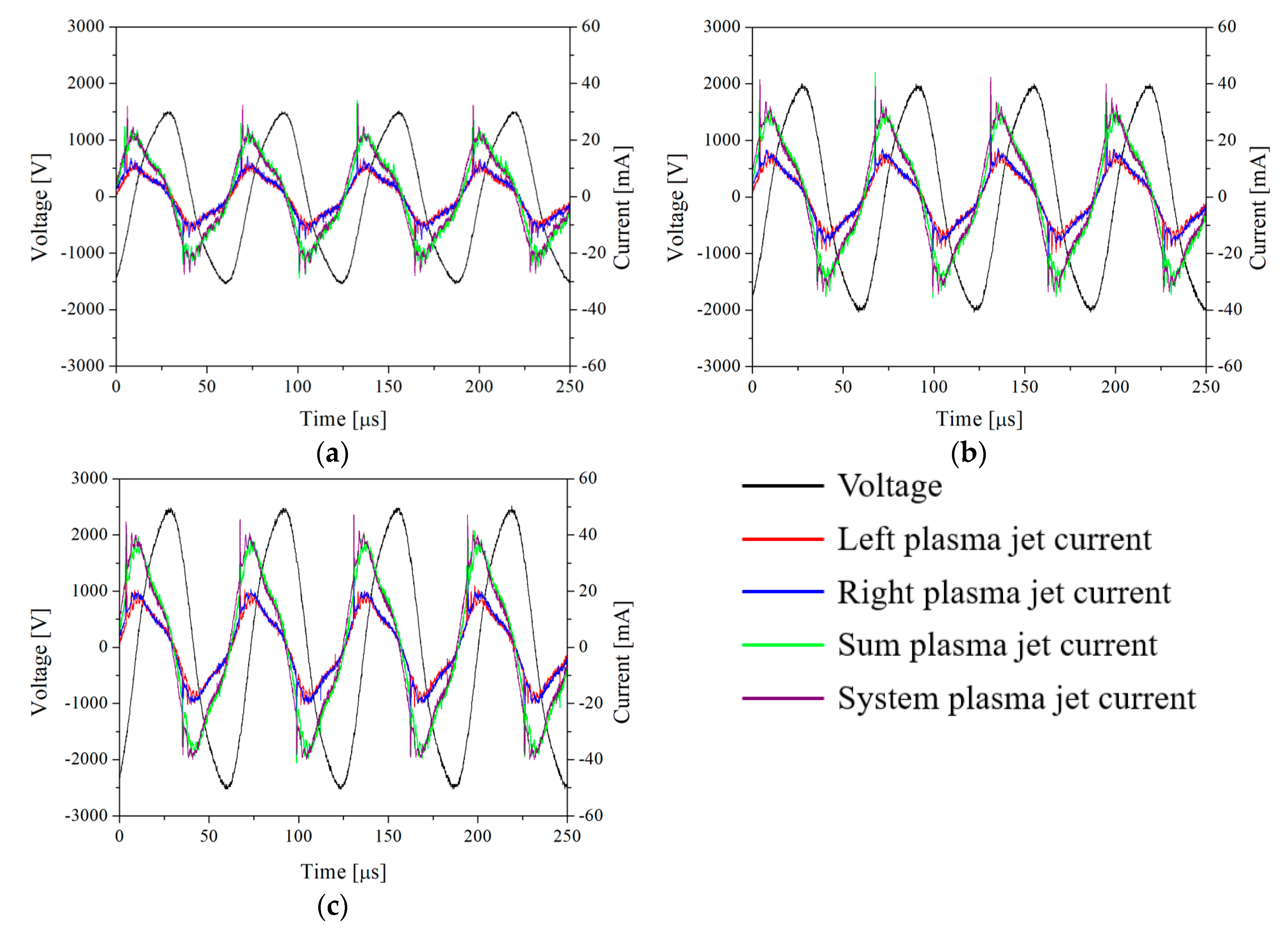


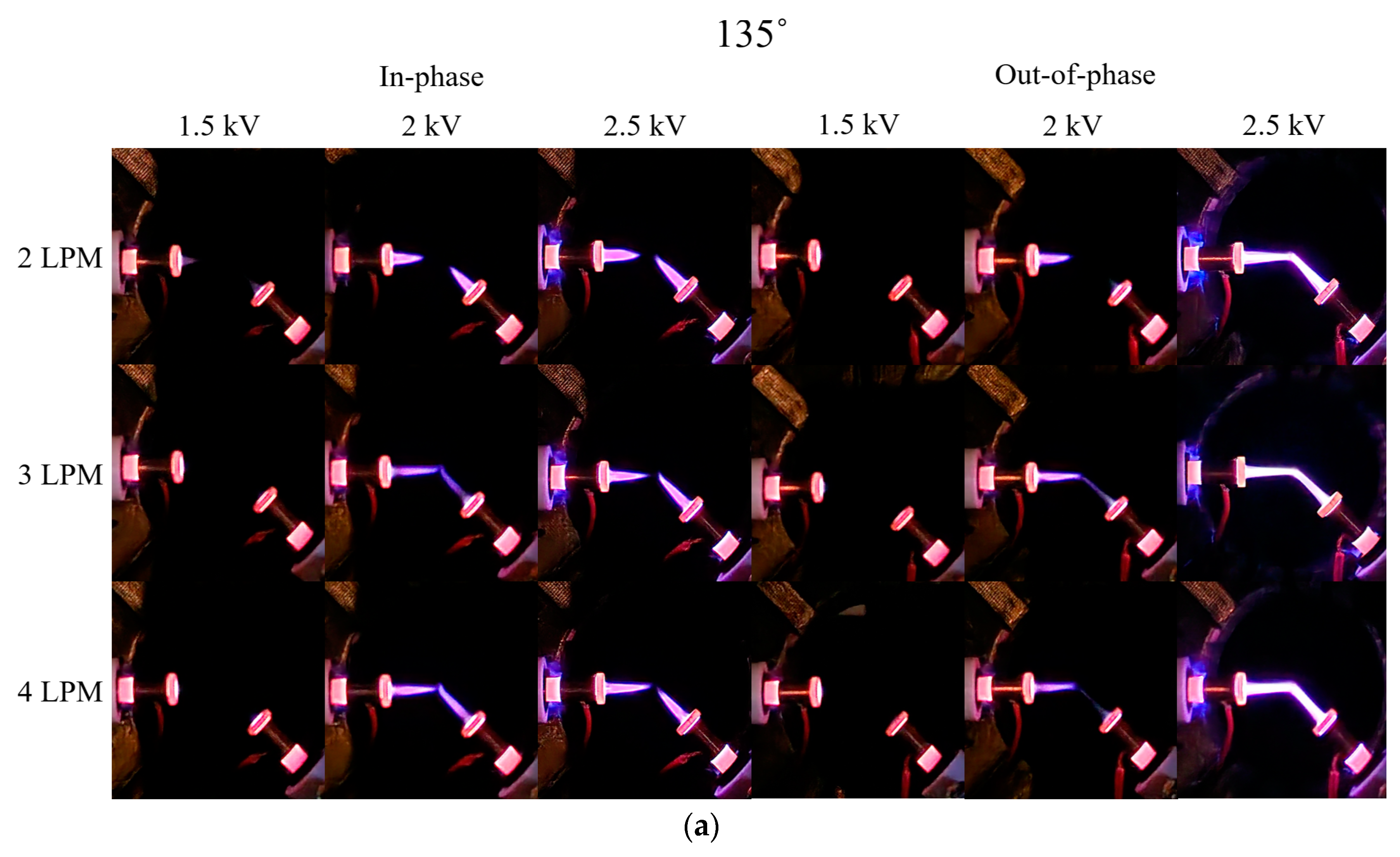
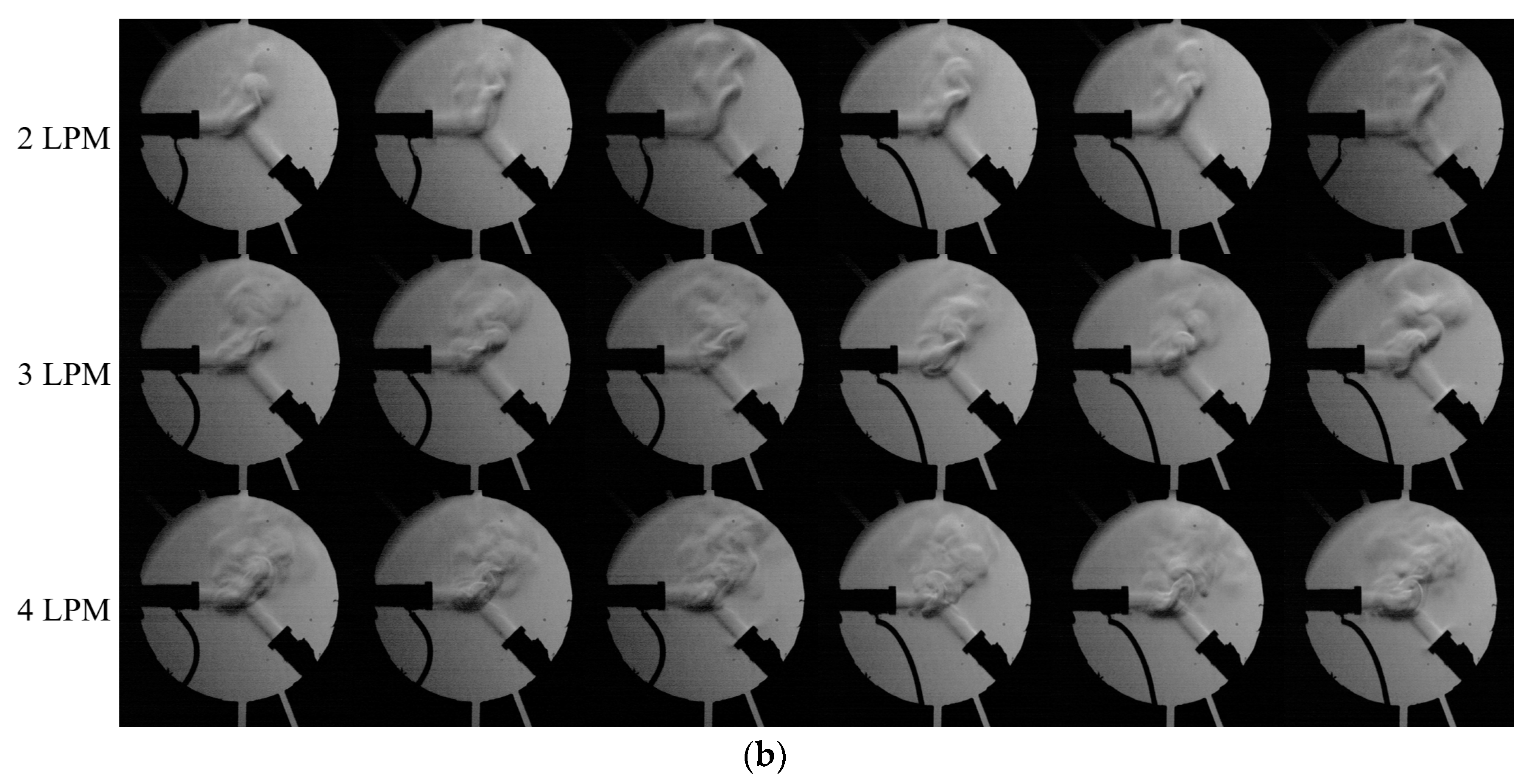
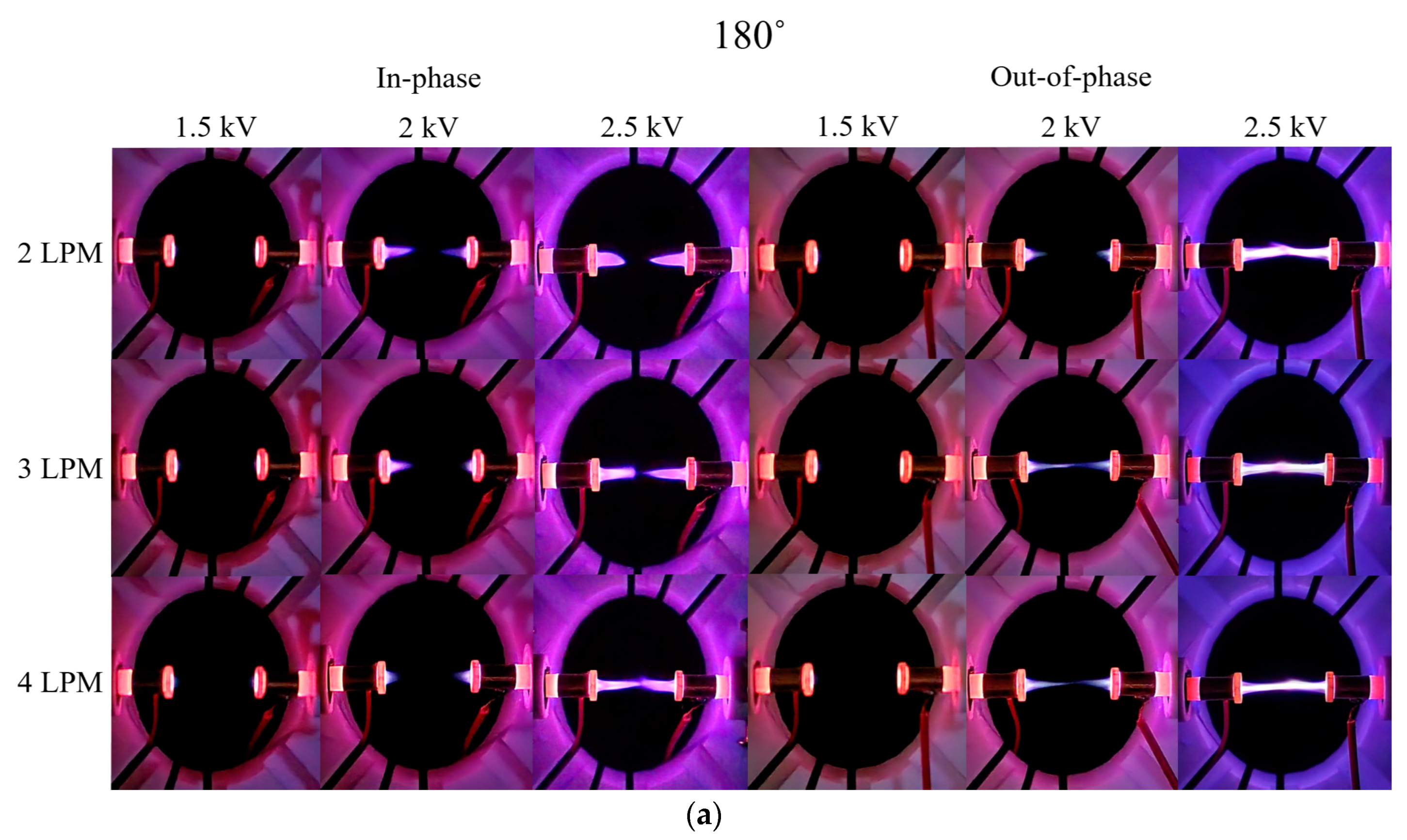



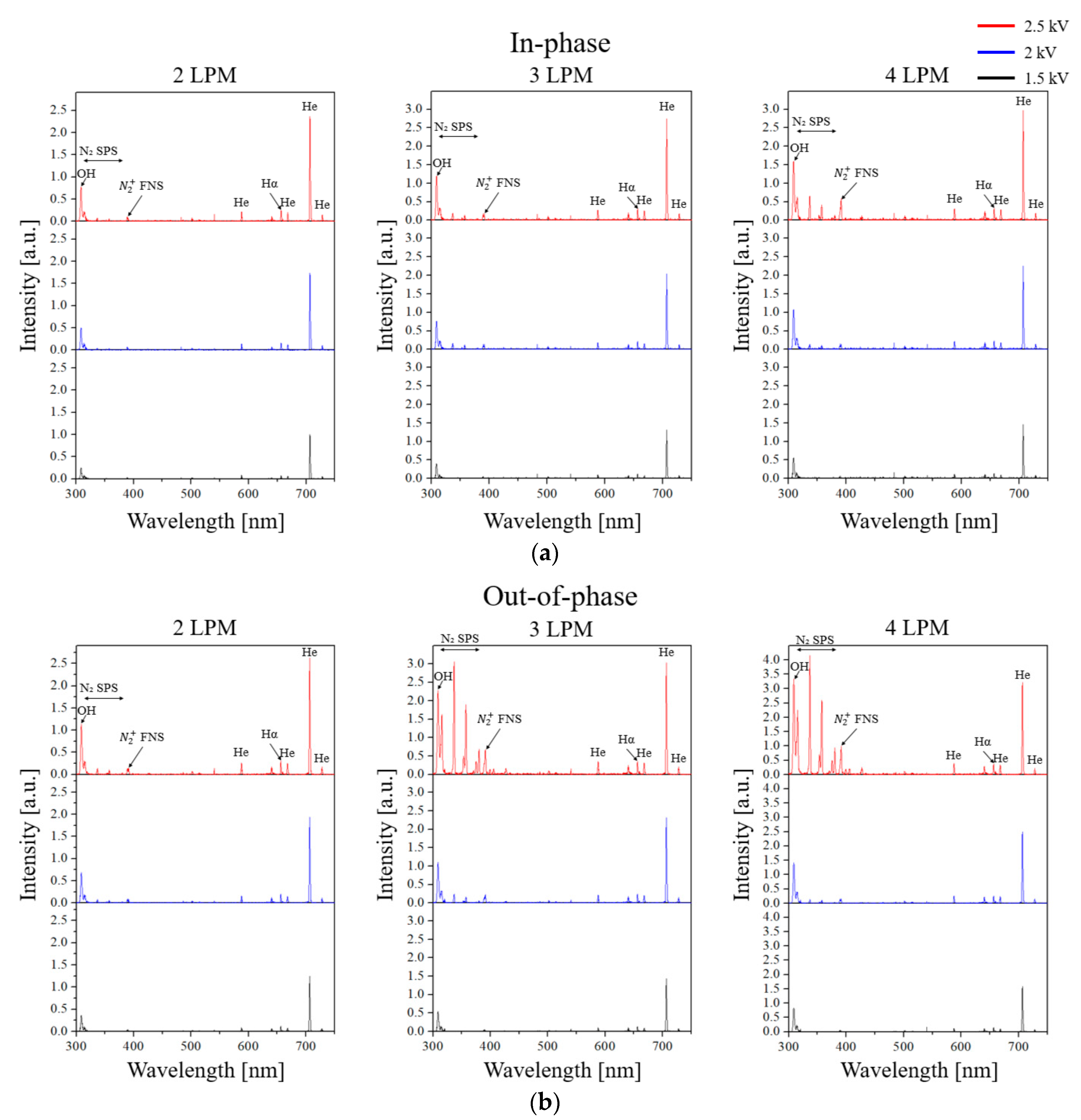

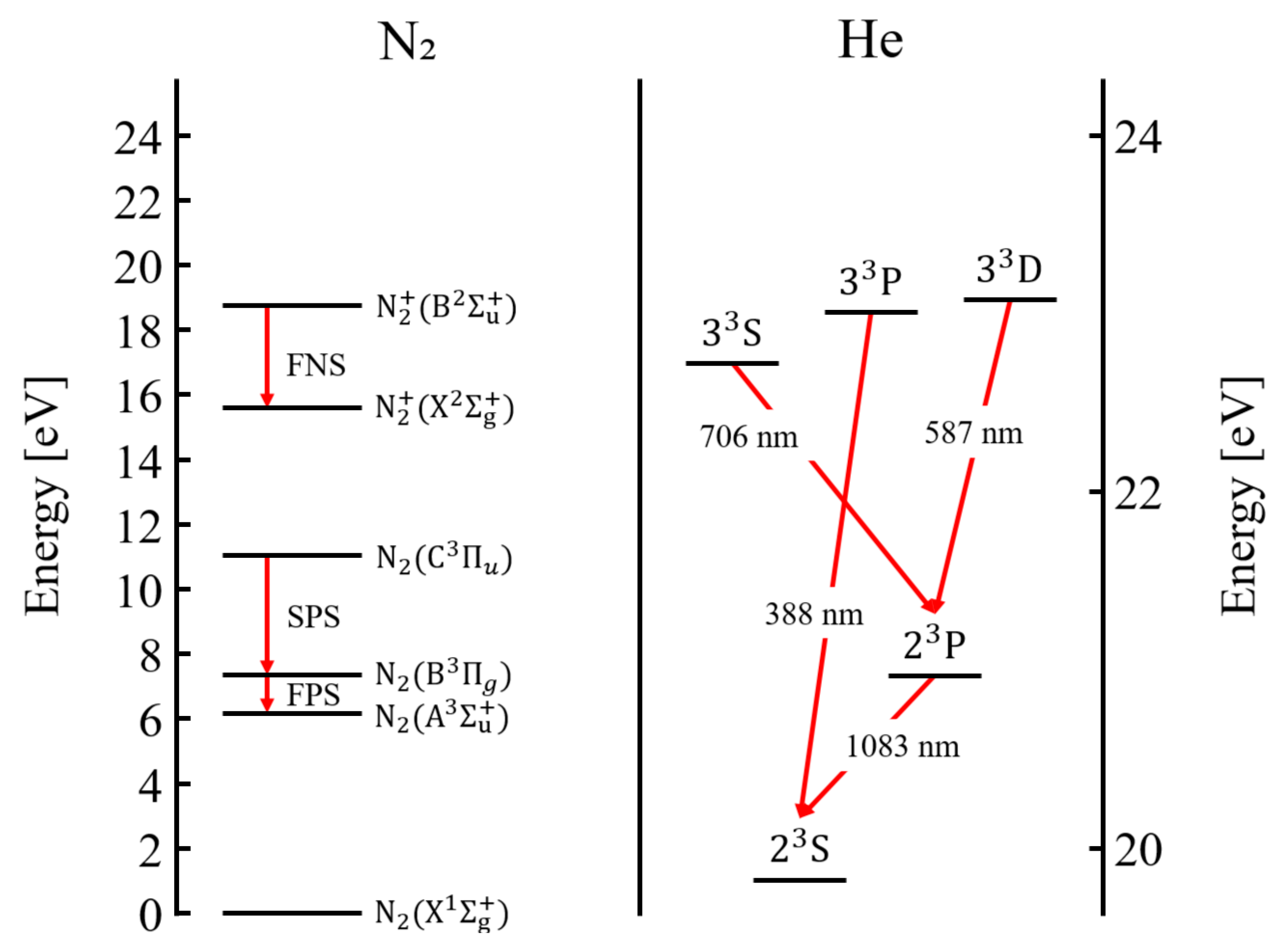
| 2 LPM | 3 LPM | 4 LPM | |
|---|---|---|---|
| 90° | 2.14 kV | 2.08 kV | 2.04 kV |
| 135° | 2.12 kV | 2 kV | 2 kV |
| 180° | 2.12 kV | 2 kV | 2 kV |
Disclaimer/Publisher’s Note: The statements, opinions and data contained in all publications are solely those of the individual author(s) and contributor(s) and not of MDPI and/or the editor(s). MDPI and/or the editor(s) disclaim responsibility for any injury to people or property resulting from any ideas, methods, instructions or products referred to in the content. |
© 2024 by the authors. Licensee MDPI, Basel, Switzerland. This article is an open access article distributed under the terms and conditions of the Creative Commons Attribution (CC BY) license (https://creativecommons.org/licenses/by/4.0/).
Share and Cite
Jeon, S.U.; Kim, J.W.; Lee, H.-Y.; Kim, G.-C.; Lee, H.J. Characteristics of Merging Plasma Plumes for Materials Process Using Two Atmospheric Pressure Plasma Jets. Materials 2024, 17, 4928. https://doi.org/10.3390/ma17194928
Jeon SU, Kim JW, Lee H-Y, Kim G-C, Lee HJ. Characteristics of Merging Plasma Plumes for Materials Process Using Two Atmospheric Pressure Plasma Jets. Materials. 2024; 17(19):4928. https://doi.org/10.3390/ma17194928
Chicago/Turabian StyleJeon, Sang Un, Jae Wan Kim, Hyun-Young Lee, Gyoo-Cheon Kim, and Hae June Lee. 2024. "Characteristics of Merging Plasma Plumes for Materials Process Using Two Atmospheric Pressure Plasma Jets" Materials 17, no. 19: 4928. https://doi.org/10.3390/ma17194928






